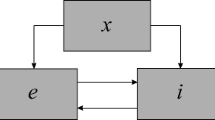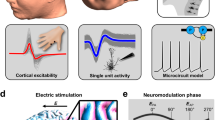Abstract
We use neural field theory and spike-timing dependent plasticity to make a simple but biophysically reasonable model of long-term plasticity changes in the cortex due to transcranial magnetic stimulation (TMS). We show how common TMS protocols can be captured and studied within existing neural field theory. Specifically, we look at repetitive TMS protocols such as theta burst stimulation and paired-pulse protocols. Continuous repetitive protocols result mostly in depression, but intermittent repetitive protocols in potentiation. A paired pulse protocol results in depression at short ( < ∼ 10 ms) and long ( > ∼ 100 ms) interstimulus intervals, but potentiation for mid-range intervals. The model is sensitive to the choice of neural populations that are driven by the TMS pulses, and to the parameters that describe plasticity, which may aid interpretation of the high variability in existing experimental results. Driving excitatory populations results in greater plasticity changes than driving inhibitory populations. Modelling also shows the merit in optimizing a TMS protocol based on an individual’s electroencephalogram. Moreover, the model can be used to make predictions about protocols that may lead to improvements in repetitive TMS outcomes.











Similar content being viewed by others
References
Bi, G.Q., & Poo, M.M. (1998). Synaptic modifications in clutured hippocampal neurons: dependence on spike timing, synaptic strength, and postsynaptic cell type. Journal of Neuroscience, 18, 10,464–10,472.
Bienenstock, E., & Lehmann, D. (1998). Regulated criticality in the brain. Advances in complex systems, 1, 361–384.
Bienenstock, E.L., Cooper, L.N., Munro, P.W. (1982). Theory for the development of neuron selectivity: orientation specificity and binocular interation in visual cortex. Journal of Neuroscience, 2, 32–48.
Bojak, I., & Liley, D.T.J. (2010). Axonal velocity distributions in neural field equations. PLoS Computational Biology, 6, e1000, 653.
Chen, R., Classen, J., Gerloff, C., Celnik, P., Wassermann, E.M., Hallett, M., Cohen, L.G. (1997). Depression of motor cortex excitability by low-frequency transcranial magnetic stimulation. Neurology, 48, 1398–1403.
Civardi, C., Collini, A., Monaco, F., Cantello, R. (2009). Applications of transcranial magnetic stimulation in sleep medicine. Sleep Medicine Reviews, 13, 35–46.
Deco, G., Jirsa, V.K., Robinson, P.A., Breakspear, M., Friston, K. (2008). The dynamic brain: from spiking neurons to neural masses and cortical fields. Public Library of Science Computational Biology, 4(8), e1000, 092.
Fitzgerald, P.B., Fountain, S., Daskalakis, Z.J. (2006). A comprehensive review of the effects of rTMS on motor cortex excitability and inhibition. Clinical Neurophysiology, 117, 2584–2596.
Freeman, W.J. (1992). Predictions on neocortical dynamics derived from studies in paleocortex In Basar, E., & Bullock, T.H. (Eds.), Induced Rhythms of the Brain, chap. 9, (pp. 183–199). Boston: Birkhaeuser.
Fregni, F., Simon, D.K., Wu, A., Pascual-Leone, A. (2005). Biophysical mechanisms of multistability in resting-state cortical rhythms. Journal of Neurology, Neurosurgery and Psychiatry, 76, 1614–1623.
Fung, P.K., Haber, A.L., Robinson, P.A. (2013). Neural field theory of plasticity in the cerebral cortex. Journal of Theoretical Biology, 318, 44–57.
Fung, P.K., & Robinson, P.A. (2013). Neural field theory of calcium dependent plasticity with applications to transcranial magnetic stimulation. Journal of Theoretical Biology, 324, 72–83.
Gerstner, W., Kempter, R., van Hemmen, J.L., Wagner, H. (1996). A neuronal learning rule for sub-millisecond temporal coding. Nature, 386, 76–78.
Gerstner, W., & Kistler, W.M. (2002). Spiking neuron models: single neurons, populations, plasticity. Cambridge, UK: Cambridge University Press.
Hallett, M. (2007). Transcranial magnetic stimulation: a primer. Neuron, 55, 187–199.
Hamada, M., Murase, N., Hasan, A., Balaratnam, M., Rothwell, J.C. (2013). The role of interneuron networks in driving human motor cortex plasticity. Cerebral Cortex, 23, 1593–1605.
Hess, G., Aizenman, C.D., Donoghue, J.P. (1996). Conditions for the induction of long-term potentiation in layer II/III horizontal connections of the rat motor cortex. Journal of Neurophysiology, 75, 1765–1778.
Huang, Y.Z., Edwards, M.J., Rounis, E., Bhatia, K.P., Rothwell, J. (2005). Theta burst stimulation of the human motor cortex. Neuron, 45, 201–206.
Jirsa, V.K., & Haken, H. (1996). A field theory of electromagnetic brain activity. Physical Review Letters, 77, 960–963.
Kempter, R., Gerstner, W., van Hemmen, J.L. (1999). Hebbian learning and spiking neurons. Physical Review E, 59, 4498–4514.
Koch, C. (1999). Biophysics of computation: information processing in single neurons. New York: Oxford University Press.
Kujirai, T., Caramia, M.D., Rothwell, J.C., Day, B.L., Thompson, P.D., Ferbert, A., Wroe, S., Asselman, P., Marsden, C.D. (1993). Corticocortical inhibition in human motor cortex. Journal of Physiology, 471, 501–519.
Lazzaro, V.D., Oliviero, A., Meglio, M., Cioni, B., Tamburrini, G., Tonali, P., Rothwell, J.C. (2000). Direct demonstration of the effect of lorazepam on the excitability of the human motor cortex. Clinical Neurophysiology, 111, 794–799.
Lazzaro, V.D., Pilato, F., Dileone, F., Profice, M., Olivero, A., Mazzone, P., Insola, A., Ranieri, F., Meglio, M., Tonali, P.A., Rothwell, J.C. (2008). The physiological basis of the effects of intermittent theta burst stimulation of the human motor cortex. Journal of Physiology, 586, 3871–3879.
Lazzaro, V.D., Pilato, F., Saturno, E., Olivero, A., Dileone, M., Mazzone, P., Insola, A., Tonali, P.A., Ranieri, F., Huang, Y.Z., Rothwell, J.C. (2005). Theta-burst repetitive transcranial magnetic stimulation suppresses specific excitatory circuits in the human motor cortex. Journal of Physiology, 565, 945–950.
Liley, D.T.J., Cadusch, P.J., Dafilis, M.P. (2002). A spatially continuous mean field theory of electro-cortical activity. Network, 13, 67–113.
Lisman, J., & Spruston, N. (2010). Questions about STDP as a general model of synaptic plasticity. Frontiers in Synaptic Neuroscience, 2, 140.
Massimini, M., Tononi, G., Huber, R. (2009). Slow waves, synaptic plasticity and information processing: insights from transcranial magnetic stimulation and high-density EEG experiments. European Journal of Neuroscience, 29, 1761–1770.
Nakamura, H., Kitagawa, H., Kawaguchi, Y., Tsugi, H. (1997). Intracortical facilitation and inhibition after transcranial magnetic stimulation in conscious humans. Journal of Physiology, 498, 817–823.
Nunez, P.L. (1974). The brain wave function: a model for the EEG. Mathematical Biosciences, 21, 279–297.
Oberman, L., Edwards, D., Eldaief, M., Pascual-Leone, A. (2011). Safety of theta burst transcranial magnetic stimulation: a systematic review of the literature. Journal of Clinical Neurophysiology, 28, 67–74.
Palmer, L.M., Schulz, J.M., Murphy, S.C., Ledergerber, D., Murayama, M., Larkum, M.E. (2012). The cellular basis of GABAB-mediated interhemispheric inhibition. Science, 335, 989–993.
Pascual-Leone, A., Valls-Solé, J., Wassermann, E.M., Hallett, M. (1994). Responses to rapid-rate transcranial magnetic stimulation of the human motor cortex. Brain, 117, 847–858.
Pérez-Garci, E., Gassmann, M., Bettler, B., Larkum, M.E. (2006). The GABA\(_{\rm B 1 b}\) isoform mediates long-lasting inhibition of dendritic Ca\(^{\rm 2+}\) spikes in layer 5 somatosensory pyramidal neurons. Neuron, 50, 603–616.
Ridding, M.C., & Rothwell, J.C. (2007). Is there a future for theraputic use of transcranial magnetic stimulation. Nature Neuroscience, 8, 559–567.
Robinson, P.A. (2011). Neural field theory of synaptic plasticity. Journal of Theoretical Biology, 285, 156–163.
Robinson, P.A., & Kim, J. W. (2012). Spike, rate, field and hybrid methods for treating neural dynamics derived from conductance-based equations. Journal of Neuroscience Methods, 205, 283–294.
Robinson, P.A., Rennie, C.J., Rowe, D.L., O‘Connor, S. (2004). Estimation of multiscale neurophysiologic parameters by electroencephalographic means. Human Brain Mapping, 23, 53–72.
Robinson, P.A., Rennie, C.J., Rowe, D.L., O‘Connor, S., Gordon, E. (2005). Multiscale brain modelling. Philisophical Transactions of the Royal Society B, 360, 1043.
Robinson, P.A., Rennie, C.J., Wright, J.J. (1997). Propagation and stability of waves of electrical activity in the cerebral cortex. Physical Review E, 56, 826–840.
Rothkegel, H., Sommer, M., Paulus, W. (2010). Breaks during 5 Hz rTMS are essential for facilitatory after effects. Clinical Neurophysiology, 121, 426–430.
Rothwell, J. (2003). Techniques of transcranial magnetic stimulation In Boniface, S., & Ziemann, U. (Eds.), Plasticity in the human nervous system: investigations with transcranial magnetic stimulation, (pp. 26–61). Cambridge, UK: Cambridge University Press.
Shouval, H.Z., Wang, S.S.H., Wittenberg, G. M. (2010). Spike timing dependent plasticity: a consequence of more fundamental learning rules. Frontiers in Computational Neuroscience, 4, 19.
Silva, S., Basser, P.J., Miranda, P.C. (2008). Elucidating the mechanisms and loci of neuronal excitation by transcranial magnetic stimulation using a finite element model of a cortical sulcus. Clinical Neurophysiology, 119, 2405–2413.
Steyn-Ross, D.A., Steyn-Ross, M.L., Sleigh, J.W., Wilson, M.T., Gillies, I.P., Wright, J.J. (2005). The sleep cycle modelled as a cortical phase transition. Journal of Biophysics, 31, 547–569.
Steyn-Ross, M.L., Steyn-Ross, D.A., Wilson, M.T., Sleigh, J.W. (2009). Modeling brain activation patterns for the default and cognitive states. NeuroImage, 45, 289–311.
Talelli, P., Wallace, A., Dileone, M., Hoad, D., Cheeran, B., Oliver, R., VandenBos, M., Hammerbeck, U., Barratt, K., Gillini, C., Musumeci, G., Boudrias, H.H., Cloud, G.C., Ball, J., Marsden, J.F., Ward, N.S., Lazzaro, V.D., Greenwood, R.G., Rothwell, J.C. (2012). Theta burst stimulation in the rehabilitation of the upper limb: a semirandomized, placebo-controlled trial in chronic stroke patients. Neurorehabilitation and Neural Repair, 26, 976–987.
Tononi, G., & Cirelli, C. (2006). Sleep function and synaptic homeostatis. Sleep Medicine Reviews, 10, 49–62.
Touge, T., Gerschlager, W., Brown, P., Rothwell, J.C. (2001). Are the after-effects of low-frequency rtms on motor cortex excitability due to changes in the efficacy of cortical synapses?Clinical Neurophysiology, 112, 2138–2145.
Walsh, V., & Cowey, A. (2000). Transcranial magnetic stimulation and cognitive neuroscience. Nature Reviews: Neuroscience, 1, 73–79.
Wilson, H.R., & Cowan, J.D. (1972). Excitatory and inhibitory interactions in localized populations of model neurons. Biophysical Journal, 12, 1–24.
Wilson, M.T., Robinson, P.A., O’Neill, B., Steyn-Ross, D.A. (2012). Complementarity of spike- and rate-based dynamics of neural systems. PLoS Computational Biology, 8, e1002,560.
Wilson, M.T., Steyn-Ross, D.A., Sleigh, J.W., Steyn-Ross, M.L., Wilcocks, L.C., Gillies, I.P. (2006). The k-complex and slow oscillation in terms of a mean-field cortical model. Journal of Computational Neuroscience, 21, 243–257.
Ziemann, U., Rothwell, J.C., Ridding, M.C. (1996). Interaction between intracortical inhibition and facilitation in human motor cortex. Journal of Physiology, 496, 873–881.
Acknowledgments
We thank Felix Fung and Peter Robinson at The University of Sydney for helpful discussions.
Author information
Authors and Affiliations
Corresponding author
Additional information
Action Editor: Simon R Schultz
Conflict of interests
None
Rights and permissions
About this article
Cite this article
Wilson, M.T., Goodwin, D.P., Brownjohn, P.W. et al. Numerical modelling of plasticity induced by transcranial magnetic stimulation. J Comput Neurosci 36, 499–514 (2014). https://doi.org/10.1007/s10827-013-0485-1
Received:
Revised:
Accepted:
Published:
Issue Date:
DOI: https://doi.org/10.1007/s10827-013-0485-1




